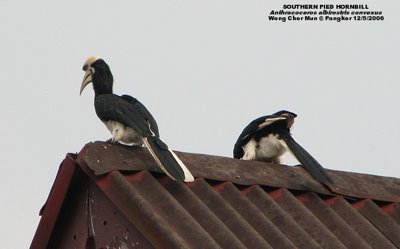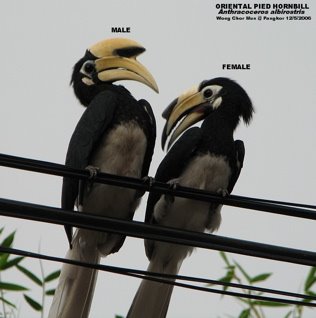Oriental Pied Hornbills in Pangkor Island, Peninsular Malaysia
 Pangkor Island is a scenic island resort off the west coast of Peninsula Malaysia. And that was where Susan Wong was holidaying recently. What impressed her most was the Oriental Pied Hornbills (Anthracoceros albirostris). There were hornbills everywhere. On rooftops, perching on high-tension wires and along roads. She even saw one bird with a deformed bill. She thought that they were as common as crows that can be seen in many Malaysian towns.
Pangkor Island is a scenic island resort off the west coast of Peninsula Malaysia. And that was where Susan Wong was holidaying recently. What impressed her most was the Oriental Pied Hornbills (Anthracoceros albirostris). There were hornbills everywhere. On rooftops, perching on high-tension wires and along roads. She even saw one bird with a deformed bill. She thought that they were as common as crows that can be seen in many Malaysian towns. 
 We in urban Singapore consider ourselves fortunate to be able to see a pair of these hornbills flying overhead or even visiting our urban gardens. In Pulau Ubin we can see more, but as common as crows? Unbelievable to most of us! I have therefore managed to persuade her to share her images of these impressive birds from Pangkor Island for this post.
We in urban Singapore consider ourselves fortunate to be able to see a pair of these hornbills flying overhead or even visiting our urban gardens. In Pulau Ubin we can see more, but as common as crows? Unbelievable to most of us! I have therefore managed to persuade her to share her images of these impressive birds from Pangkor Island for this post.  According to Susan: “The birds have been behaving this way for the last ten years.” They have been attracted to certain touristy areas where hotels and restaurants are plentiful. The residents feed them with leftover food as a tourist attraction. Because of this the birds have become so tame that it is almost possible to touch them. In fact Susan says that they look ”…more tame than the birds at bird parks and zoos.” In fact they have become as tame as the Eurasian Tree Sparrow (Passer montanus). Although there is a patch of lowland rainforest nearby, the hornbills were content to be around people.
According to Susan: “The birds have been behaving this way for the last ten years.” They have been attracted to certain touristy areas where hotels and restaurants are plentiful. The residents feed them with leftover food as a tourist attraction. Because of this the birds have become so tame that it is almost possible to touch them. In fact Susan says that they look ”…more tame than the birds at bird parks and zoos.” In fact they have become as tame as the Eurasian Tree Sparrow (Passer montanus). Although there is a patch of lowland rainforest nearby, the hornbills were content to be around people. Our bird specialist R. Subaraj has this to say: “Based on the timings for flock gatherings at Pangkor, given by Susan, I am of the opinion that while this hornbill is unquestionably common on the island, the larger gatherings are because they roost communally. From dawn onwards, they are together drying and warming up before dispersing to find food while in the evenings they probably start gathering until near dusk, when they go to roost together.”
Input and images by Susan Wong of Malaysia.
Labels: Hornbills



2 Comments:
Great pic, love it, at 1st sight look like Tucan usually found in Southe America. Thanks for sharing Joy
Hi Prof Wee,
I did my final year thesis at Cherating. In the mornings, there too were hornbills, though I'm not sure what specie they belong to for a birder I'm not. Unfortunately, photographs of them I have none.
Zaki
Post a Comment
<< Home